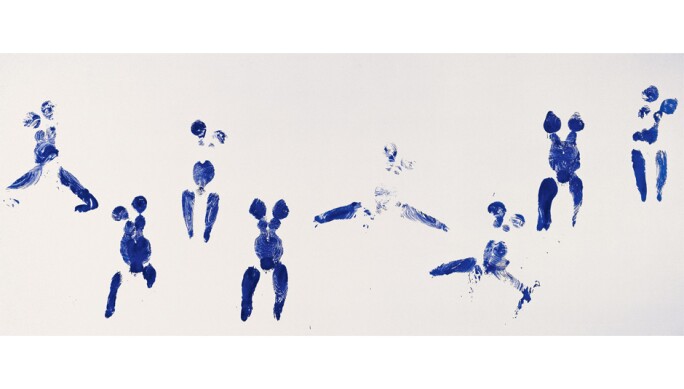
Yves Klein, Untitled Anthropometry (ANT 106), 1960, Courtesy of Yves Klein Archives
Sixty years ago in Paris, 3,000 people queued up to see the latest work by Yves Klein, the city’s hottest young artist fresh from a lauded one-man exhibition in Milan. Little did they know that they were waiting to be let into an empty room. “It was a completely new language,” says Daniel Moquay, coordinator at the Yves Klein Archive, on Klein’s seminal exhibition The Void at the Iris Clert Gallery. “His work took people by surprise, but in it they discovered a completely different kind of experience.”

Yves Klein, Untitled Blue Monochrome (IKB 67), 1959
© The Estate of Yves Klein c/o ADAGP, Paris, 2018
Klein’s hugely influential career lasted just seven years, before he died at the age of 34 in 1962. He is remembered above all for a single colour, a rich ultramarine that he patented with his own name: International Klein Blue (IKB). He used this colour in almost all of his work, from performance and installation to sculpture and painting, including his controversial Anthropometry series from the early 1960s that saw naked women covering themselves in IKB paint and imprinting their bodies on giant canvases. But his influence goes far beyond a single colour.

Yves Klein's performance Anthropometries of the Blue Period, 1960, Galerie Internationale d'art contemporain, Paris, France
© Photo: Charles Wilp / BPK, Berlin
He began painting as a teenager, but very early on he realised that he was as interested in ideas and experiences as he was in the artwork itself. “There is a wonderful story about how he came to make his first ‘artwork’,” says Kerry Brougher, director of the Academy Museum of Motion Pictures in Los Angeles, who co-curated a major Klein retrospective at the Hirshhorn Museum in Washington DC in 2010. “At the age of nineteen, he is lying on a beach in Nice and imagines himself levitating up into the blue sky, coming back round on the other side and signing it like an artist would. Right from the start, before he even coins himself an artist, he is using the earth and sky as his materials.”

Yves Klein in the "void" room of his Sensibilité Picturale Immatérielle, Museum Haus Lange, Krefeld, Germany, 1961
© The Estate of Yves Klein c/o ADAGP, Paris, 2018, © Photo: Charles Wilp / BPK, Berlin
For an artist so fascinated by the conceptual possibilities of art, Klein never ignored the spiritual aspect of his work. “Klein used colour as an instrument of revelation and a gateway to the soul,” says Klaus Ottmann, director of the Phillips Collection in Washington DC. “His viewers partake in the work by becoming immersed in the void of pure colour.” Blue had a particular resonance for Klein, a devout Catholic. “Since ancient times, the colour blue has been associated with wisdom, moral philosophy and truth.”

Yves Klein in the "void" room of his Sensibilité Picturale Immatérielle, Museum Haus Lange, Krefeld, Germany, 1961
© The Estate of Yves Klein c/o ADAGP, Paris, 2018, © Photo: Charles Wilp / BPK, Berlin
He used simple concepts to create unique encounters for the viewer, a process that has had a profound influence on contemporary art. “Klein opened a path to new conceptual, performative and immersive practices, which continue to shape and define today’s experiences of art,” says Ottmann. “He cut himself off from any existing traditions. His vision was a future of absolute artistic and social freedom.”

Yves Klein, Untitled Blue Monochrome (IKB 129), 1957
© The Estate of Yves Klein c/o ADAGP, Paris, 2018
Throughout The Void's anniversary year, museums around the world are displaying works by Klein. In France, works on loan from the Yves Klein Archives are featuring as part of major group exhibitions at the Fondation Louis Vuitton in Paris, the MUCEM in Marseille, and the Centre Pompidou-Metz. Elsewhere, large-scale exhibitions in Denmark and Hong Kong will display monochrome sculptures and paintings by Klein. Moquay sees this string of internaitonal exhibitions as part of a wider recognition of Klein's significance. "Klein has opened so many doors for young artists today," he says. "My vision is that one day there will be an Yves Klein corner in every museum in the world."

Yves Klein and le Globe terrestre bleu (RP 7), 1961
© Photo: Harry Shunk and Janos Kender, © The Estate of Yves Klein c/o ADAGP, Paris, 2018, © J.Paul Getty Trust. The Getty Research Institute, Los Angeles.